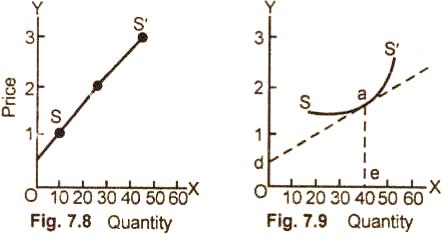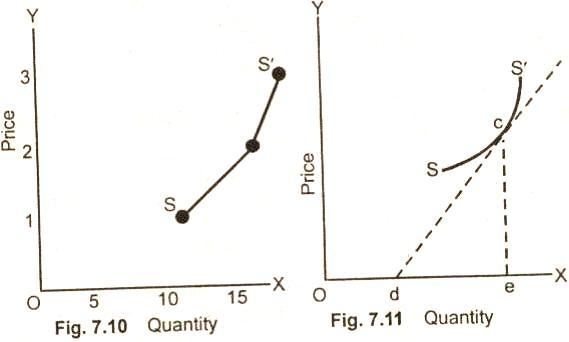Elasticity of supply can be measured on the very same lines as we measured
the elasticity of demand. Elasticity of supply can either be equal to unity or
greater than unity or less than unity.
Equal to Unity:
If a, change in the
quantity supplied, and a change in the price vary in equal proportion, the ratio will be equal to one and the
elasticity of supply will be equal to unity.
Diagram/Figure and
Schedule:
This is shown with the help of the schedule and the diagrams given below:
| Price ($) |
Quantity
Supplied (Kg) |
| 1 |
10 |
| 2 |
20 |
| 3 |
30 |

If the supply curve is a straight line and is also equal to unity, it will
pass through the origin as is shown in Fig. 7.6. If the point on the arc supply
curve is such that the tangent passes through the origin, the elasticity at the
point will also be equal to unity as is shown in Fig. 7.7.
Greater than Unity:
If a change of 1 percent in price
leads to more than 1 percent change in supply, the elasticity is said to be
greater than unity.
This is shown with the help of the
schedule and the diagrams given below:
| Price ($) |
Quantity
Supplied (Kg) |
| 1 |
10 |
| 2 |
25 |
| 3 |
45 |

In Fig. 7.8, the supply curve SS/ cuts the Y-axis, the elasticity is greater
than unity. If the supply curve is an arc, then the point on the curve whose
tangent cuts the price axis will have elasticity greater than unity as is shown
in diagram 7.9.
Less
than Unity:
If a 1 percent change in price is accompanied by less
than 1 percent change in supply, the elasticity of supply is said to be less
than unity.
| Price ($) |
Quantity
Supplied (Kg) |
| 1 |
10 |
| 2 |
15 |
| 3 |
17 |

If the supply curve cuts the X-axis, the elasticity will be less that unity
as is shown in fig. 7.10, and Fig. 7.11. The tangent at point C intersects the
X-axis at the point d. This means elasticity of supply is less than one.